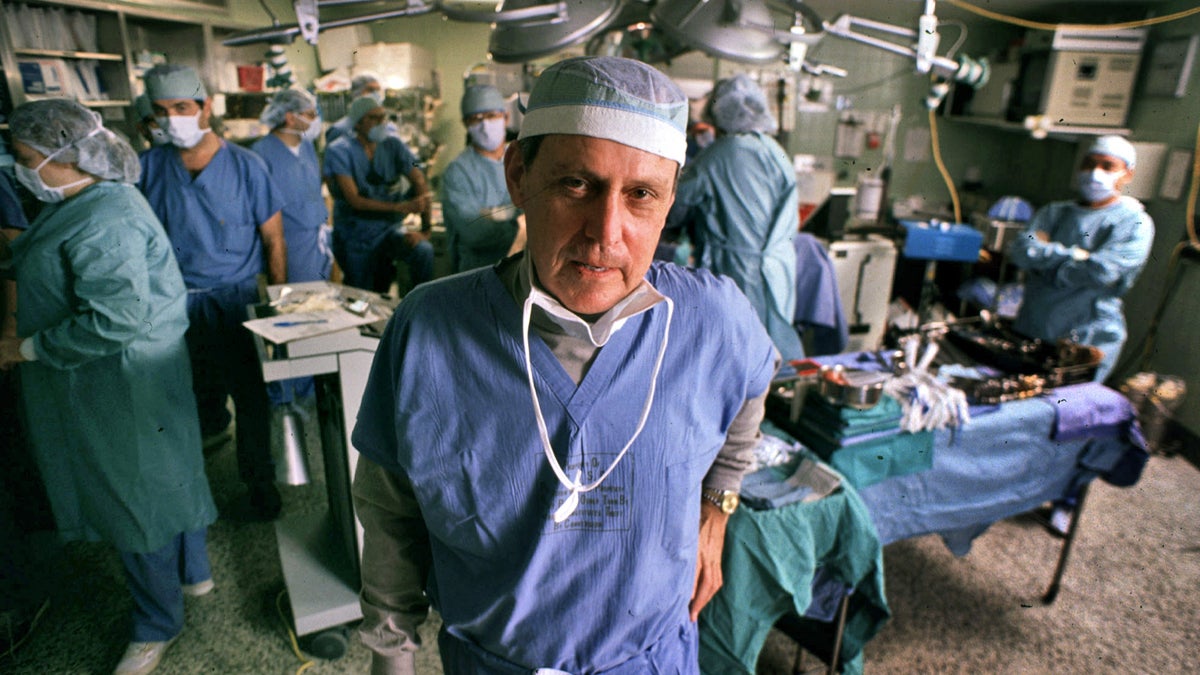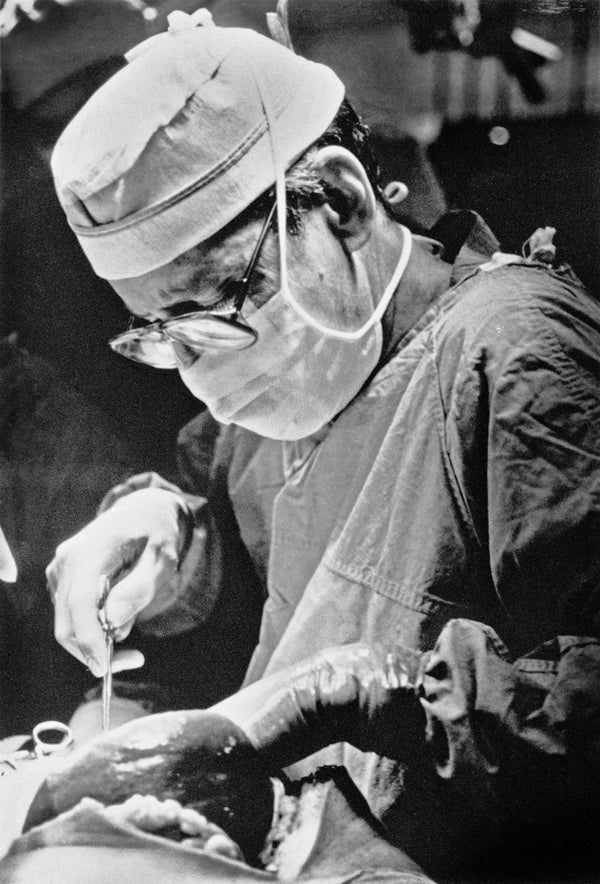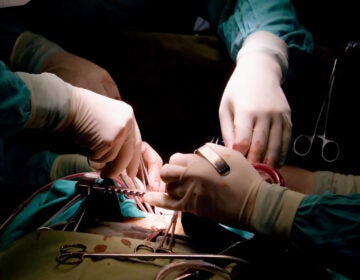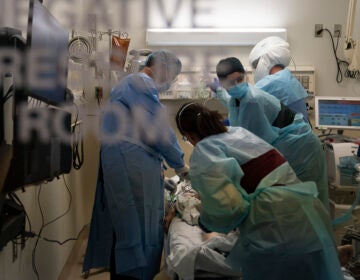Remembering Thomas Starzl and the frenzied work that advanced organ transplants
Thomas Starzl, whose death at age 90 was in the news last week, was the most driven man I've ever met.

Transplant pioneer Dr. Thomas Starzl is shown on Nov. 10, 1989, overseeing a liver transplant operation at the University of Pittsburgh Medical Center. Starzl died at the age of 90 on March 4 at his home in Pittsburgh. (AP Photo/Gene J. Puskar/File)
“The secrets are within them, hidden beneath a pile of emotional stones which only they have a right or the knowledge to probe.” —Thomas Starzl, writing in his memoirs, “The Puzzle People,” about the aspirations of the first generation of transplant surgeons.
Thomas Starzl, whose death at age 90 made the news last week, was the most driven man I’ve ever met.
I got to know him a little back in 1986. I was a reporter for The Wall Street Journal, and my editor said there must be a story in the organ-transplant program that Starzl was building at the University of Pittsburgh’s Presbyterian and Children’s hospitals — go see.
I could not have guessed what I was about to witness.
Starzl was furiously making Pittsburgh the international capital of transplantation — most prominently the liver transplants he had pioneered, but other transplants as well. A member of the Starzl team once transplanted five organs into the same patient. At age 60, Starzl had surgical fellows half his age struggling to keep up with him. Sleep? What was sleep?
By that time, cutting out a liver and replacing it with another was no longer so absurdly difficult that it might be seen as heroism bordering on the unethical; it had become merely absurdly difficult. Blood from other abdominal organs that passes through the liver must be re-routed to reach the heart. Care must be taken with bile ducts, lest bile spill into the abdominal cavity. The tiny vessels that may proliferate in liver disease spout when severed. Amid the blood, they must then be sutured, clipped, or cauterized. All the while, the surgeon’s hands must work for access under the ribs to perform these manipulations. A typical operation might take eight hours; a forbidding one, 20 hours.
When I first beheld the transplantation of a cirrhotic liver, I had two thoughts: “I don’t believe what I’m seeing,” and “I’ll never drink another drop of alcohol,” though this second notion soon passed the way of most resolutions.
The procedure in Pittsburgh would be preceded by another, the trip to “harvest” a cadaver organ. Late one night, I accompanied Starzl on a jet to Georgia, where a young man had died in a small-plane crash. But after Starzl removed the liver, he immediately called Pittsburgh — Stop, this liver is injured; it won’t do —because at that moment, surgeons in Pittsburgh were already preparing for surgery so they could immediately transplant the liver from Georgia and restore its blood supply. Minutes mattered.
As Starzl worked that night, a visiting surgeon from Spain stepped back from the table for a moment, gesturing with his hands as if mimicking Starzl, dumbfounded by the man’s prowess. He could not have known that, years later, Starzl would write in retirement that he “was not emotionally equipped to be a surgeon,” that he committed to surgery as “the end of the line” after false starts in other research careers, that he felt “an intense fear of failing the patients,” that there had been times when he was “sick with apprehension” and “almost unable to function” until an operation got under way.
I would never presume to understand. He was complicated.
 (Courtesy of UPMC/University of Pittsburgh)
(Courtesy of UPMC/University of Pittsburgh)
The Starzl team was doing liver transplants at an unheard-of rate, approaching one every other day. I couldn’t help wondering — and I’ll speculate that Starzl couldn’t, either — whether this racing enterprise, this prodigious display of technical virtuosity and endurance, was in danger of getting too big, too fast. The door frame of his office was layered with little pink sheets of phone messages, up the frame, across, and down — among them desperate appeals from patients and their doctors seeking what they heard Pittsburgh could deliver.
The story I did for the Journal had to do with a 76-year-old woman named Iola Miller. She was from Butler, a town near Pittsburgh. When she arrived at Presbyterian, her face was jaundiced, her abdomen swollen with fluid. Some on the Starzl team became palpably anxious when he remarked, “She should be done.” Until then, he had never ventured to do a transplant for anyone older than 67.
A liver transplant could give the right patient more good years when nothing else could. It might also end in a bad death. Starzl, who was capable of stunning candor, would himself sometimes remark on the intrinsic violence of his profession. And it wasn’t as if Miller, like so many others arriving in Pittsburgh, was yet at death’s door. Starzl feared a sudden decline in her health would compromise the chance of surgical success, yet she might get another year or two without surgery at all. Her case was the more problematic for her age. With livers in short supply, should an elderly person get one? University philosophers were called in to consult.
When I last saw Iola Miller, the jaundice had cleared and the swelling had subsided. She told me she had no doubt she had made the right decision in going forward with the transplant. Indeed, her recovery immediately after surgery would have been thought fast even for a younger patient. Inquiring after her a couple months later, I learned that she was home and keeping up with her physical therapy.
No, I haven’t inquired since.
That was one story from a world of round-the-clock work under excruciating pressures, a world where crises, disasters, and seeming miracles had become the everyday. There were, of course, countless other stories I never witnessed.
Here’s one. A nurse answers a phone and holds it to Starzl’s ear even as Starzl and another surgeon are closing the abdomen of a child who just got a new liver. It’s a call from a surgeon in Steubenville, Ohio, a Dr. Terezis. A nurse in Ohio is holding a phone to his ear as he keeps his finger in the hole of a large vein connected to the ruptured liver of a teenager rushed to the hospital after a motorcycle accident. Terezis knows Starzl can do a partial liver removal that might help. Starzl tries to beg off. He has been doing surgery for 24 consecutive hours. Terezis says he’s running out of blood supplies. The kid’s dying. Starzl hops a helicopter to Steubenville. The kid gets his life back.
True story? It must be. Starzl told it in his memoirs by way of saying that, during the chopper ride home, he felt an odd sensation in his chest for the first time, though years passed before he would undergo a coronary bypass.
In 1989, Starzl began trialing a drug called FK506. It became a breakthrough in preventing organ rejection. The pace was still accelerating. That year Pittsburgh did 339 liver transplants.
In time, though, the numbers ebbed as Starzl-trained surgeons initiated their own programs elsewhere. I once asked Starzl whether he thought the need in this country for liver transplants — 5,000 per year, by one estimate at the time — could be met if enough programs got up and running. “Easily.” The number last year: 7,841.
While working on that story about Iola Miller, I did a phone interview with one of Starzl’s former protégés. This man, himself by then a prominent surgeon, had more important things to do than to take a call from a newspaper. But once we started talking, his memories of the Pittsburgh years kept welling up. We talked for four hours straight.
Thomas Starzl died last Saturday. Now a week later, I would guess some surgeons are talking still.
—
Richard Koenig is a NewsWorks contributor and the author of “No Place To Go,” an Amazon Kindle Single concerning the need for better sanitation in the developing world. He lives in Newtown Square, Pennsylvania.
WHYY is your source for fact-based, in-depth journalism and information. As a nonprofit organization, we rely on financial support from readers like you. Please give today.




